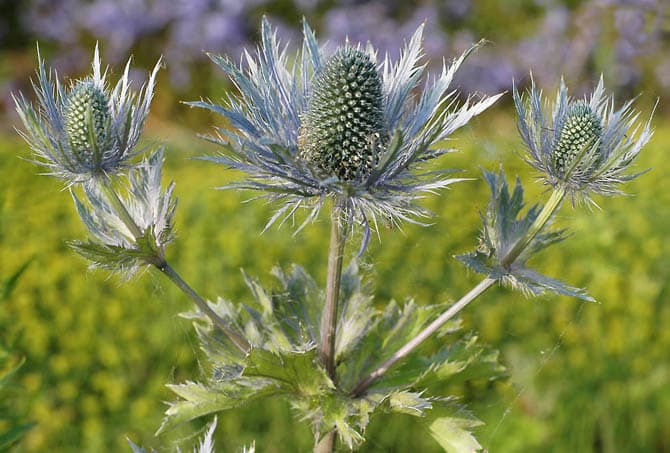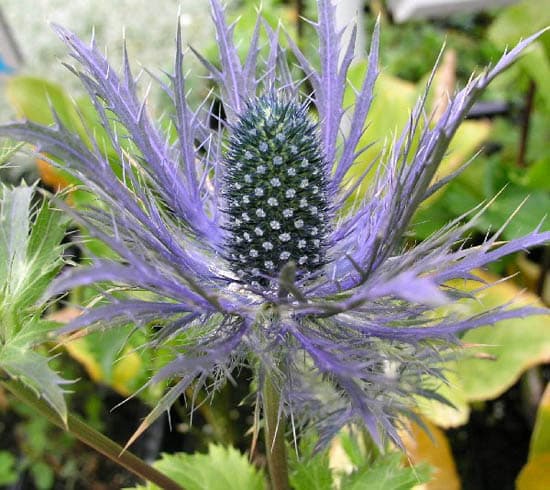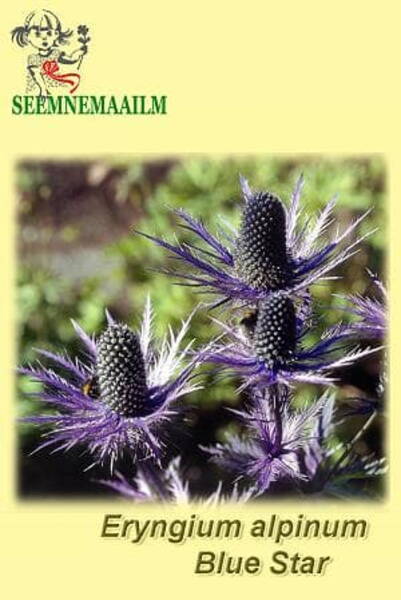Origin: alpine meadows of Europe.
Flowering plant height: 80 cm.
Natural flowering period: June - August.
Winter hardiness: Z4 - Z9.
Growth habit: strong, erect.
Foliage: shiny, heart-shaped.
Distance between plants: 60 cm.
Soil Requirements: well-drained soil, pH 6.8–7.2.
Location: Full sun, but does not like extreme heat and humidity.
Use: rock gardens and borders.
* Eryngium is a fairly easy plant to cultivate. There is only one necessary condition for its flowering: a bright, sunny place. Of course, it is so hardy that it will grow in the shade, but there you will not see all the beauty of the plant, since eryngium acquires its unique blue, blue or steel tint only in bright sunlight. Even in light partial shade, the stems stretch, turn pale and lie down, and the inflorescences turn out loose. Any soil is suitable, but for brighter colors of inflorescences, dry, poor soils - sandy or rocky - are preferred.
True, the exceptions are alpine eryngium and eryngium proteeflorum - they need soils that are quite rich and moisture-absorbing, then they will thank you with taller stems and large inflorescences. Eryngiums are very responsive to the addition of lime, which contributes to more intense coloring.
Caring for the plant consists of regular weeding and loosening. Eryngium capillaries are sclerophytes (sclerophylls), i.e. hard-tissue, drought-resistant (xerophilic) rigid-leaved plants. Thanks to this, when there is a shortage of water, plants are not in danger of wilting; in other words, during a drought, you can use water reserves to water other plants. Sometimes tall eryngiums are advised to be tied up, but if the soil is not too fertile, the stems grow strong and do not require tying even in a windy place. Most species of eryngium in Estonia are quite winter-hardy, with the exception of eryngium varifolia, eryngium agavi-folium and c. proteaflorum (Eryngium proteaeflorum).
The eryngium is propagated by seeds and by dividing the bush. In general, it is not recommended to propagate by division due to the rather fragile roots and, as a result, low survival rate, but an adult two-three-year-old bush can be replanted (transferred) with a large lump of earth in the spring before the leaves grow.
Eryngium is a good honey plant that attracts numerous bumblebees, hover flies and bees, which is very desirable not only for the garden, but also for photography enthusiasts.
1.0 g = 220 seeds.

Best Sowing Date: November - March
Way of Germination: Cold Germinator
Germination: These species usually show excellent results if sown soon after the harvest, although most of them only germinate in spring after the effect of winter. For best results please order seeds in time.
The sowing of coldgerminators must be kept warm (about +18 to 22°C) and moist for the first 2-4 weeks. After this period the sowing must be kept at a cold temperature (between -4 and +4°C) for another 4-6 weeks. It is not so important if the temperature is higher of lower during the cooling period, but the cooling period has to be prolonged because the synthesis of the germination inducer, homonlike acid, slows down or comes to a standstill.
It is beneficial to cover the sowing with snow during the cooling period. After this cooling period the sowing may not be immediately exposed to high temperatures. The most effective temperatures are between +5 to 12°C, even if germination has started. The best location for this sowing, even in March, April and May, is open field, the cold frame or a cold greenhouse.
Germination to Transplant: 4 - 8 weeks
Transplanting to salable Plant: 6 - 10 weeks
Fertilization: Low.

Alpine sea holly.















